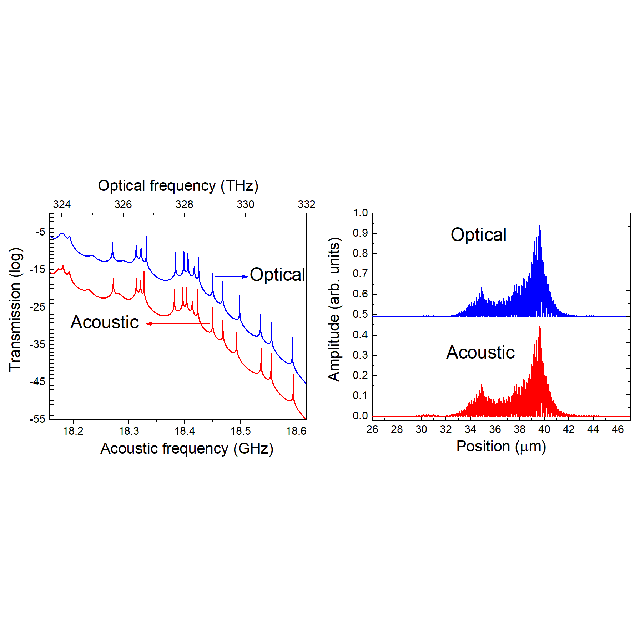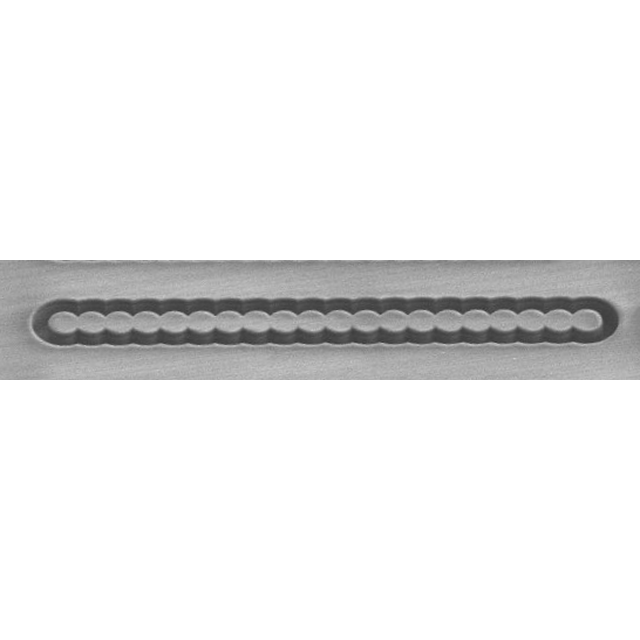News from Institut de physique (INP) of CNRS - April 29, 2019 (released in French)
Physicists have proposed a novel approach to confine light and sound waves at the same place using an approximately periodic nanoscale stack of two materials. They not only show that light and sound can be co-localized, but also show a subsequent enhancement of their interaction.
The propagation of light in solid materials can be controlled by introducing a periodicity in the solid’s structure on a length scale comparable to the wavelength of light. Moreover, the existence of disorder in periodic structures can induce localization of waves: this is the so-called Anderson localization. In the same way, acoustic waves -which constitute the movement of atoms and which are a generalization of sound waves up to microwave frequencies- can be localized. In this work, a collaboration between a specialist on interactions of acoustic and light waves from the Centre de nanosciences et nanotechnologies (C2N, CNRS/Univ. Paris-Sud) and Catalan physicists1 specialized in Anderson colocalization, has found periodic structures composed of stacks of nanometric layers of GaAs and AlAs, in which a certain degree of disorder allows the co-localization of these two types of waves. While this co-localization was already studied in nanometric cavities, this new approach will make it possible to overcome certain difficulties in the experimental realization of nanostructures and to exploit the strengths of the interaction between sound and light more easily.
The researchers have modelled the wave propagation in a nanoscale semiconductor structure composed of a series of GaAs layers (gallium arsenide, about 62 nm thick) and AlAs (aluminum arsenide, approximately 73 nm), introducing a random variation of their thicknesses so that the total thickness of the unit cell is constant. The propagation of the waves in this structure is determined by their reflection and their transmission at the interfaces between the layers and thus depends essentially on the contrast of the velocities in GaAs and AlAs, that is the relation between the two indices of refraction for the light and between the two acoustic impedances for the sound. Identical conditions of propagation and therefore of localization are obtained if these ratios are equal. This is shown by the modelling carried out by the physicists in this work and illustrated in the figure below: with ratios of speed close to 1.19 for the two chosen materials (both for light and sound), there is an almost perfect co-location of near-infrared light of wavelength 870 nm and hyper-sound of a frequency of 18 GHz.
This work shows that disorder can be exploited to co-localize near-infrared light and ultra high frequency sound in nanostructures. These structures can be grown by evaporation of the materials and deposition of the successive layers, a "bottom-up" manufacturing allowing very good control of the layer thicknesses. Thanks to such a co-localization, the coupling of light and sound is enhanced and it opens new perspectives, for example to study optomechanical interactions, for the realization of ultra-fast optical modulators and for the coupling between quantum bits.
1 Catalan Institute of Nanoscience and Nanotechnology (ICN2)
References:
Anderson photon-phonon colocalization in certain random superlattices, G. Arregui, N. D. Lanzillotti-Kimura, C. M. Sotomayor-Torres and P. D. García, Physical Review Letters, 1st February 2019.
Contact:
Daniel Lanzillotti-Kimura, CNRS researcher at C2N
Figure: Colocalization of photons and phonons in a quasi-periodic structure: for each acoustic mode there is an optical mode with the same spatial distribution.
(Left) Spectrum of acoustic and optical transmission. (Right) Amplitudes of the electric and acoustic shift fields showing the perfect co-location between the optical mode at 327.68 THz and the acoustic mode at 18.38 GHz.









